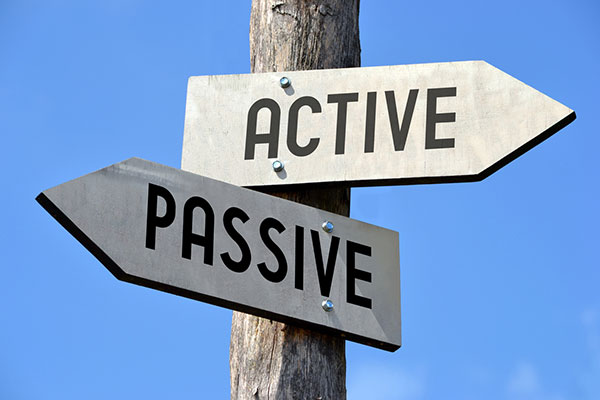Active or passive: the ultimate guide to investing your ISA
Fees, performance and a changing investment backdrop will influence which strategies perform best.
12th February 2025 11:54
by Sam Benstead from interactive investor

One of the biggest ISA investment decisions that everyone must make is whether to buy active or passive funds – or combine the two.
While some investors believe it’s best to invest in an actively managed fund, in which a manager and team of researchers pick the shares they believe will perform best, others think the best option is to buy a passively managed fund, which mirrors the ups and downs of a specific market index.
- Invest with ii: Open a Stocks & Shares ISA | ISA Investment Ideas | Transfer a Stocks & Shares ISA
Rather than picking one over the other, most investors opt for a mix of the two approaches in their portfolios. But having a good understanding of the difference between the two approaches is crucial. Let’s start by explaining the basic differences.
What are active and passive funds?
An active fund has a manager and a team of researchers who select the shares they believe will perform best. The idea is that the skill of the manager, combined with their research capabilities, allows them to identify the shares that are likely to excel. This can include smoothly navigating the economic backdrop, such as changing inflation and interest rates.
To measure their performance, funds often use a stock market index as a benchmark. This benchmark is chosen to be comparable to the portfolio of stocks that the manager puts together. For example, a manager who buys UK shares may use the FTSE All-Share index as their benchmark.
The return of a fund over a given period is then measured against the benchmark. A fund manager who provides returns higher than the benchmark is said to be “outperforming”, while those providing returns lower than the benchmark are “underperforming”.
- Watch our Fundamentals video: what is a passive fund and is this the best way to invest?
- Watch our Fundamentals video: what does a fund manager do?
Active funds are generally more expensive as the manager’s salary and their resources cost money. A typical active fund will charge somewhere between 0.75% and 1% a year (known as the ongoing charges figure), which is higher than most passive funds, where 0.1% to 0.2% a year is typical.
Two new additions to our Super 60 list of fund ideas offer exceptional value for passive investors. The SPDR S&P 500 ETF GBP (LSE:SPX5) costs just 0.03% and the SPDR® MSCI World ETF GBP (LSE:SWLD) costs just 0.12%.
In contrast to active funds, passive funds simply hold all the stocks in an index. Rather than trying to buy the best shares, passive funds aim to replicate the performance of an index.
A simple way to understand the difference between active and passive is to think of active managers as trying to uncover needles (good shares) in a haystack (the market). Passive funds, meanwhile, buy the whole haystack, knowing that the needles are in there somewhere.
Passive funds come in two forms: index funds and exchange-traded funds (ETFs). The core difference is that unlike index funds, ETFs can be traded throughout the day on the stock market, much like individual stocks. For long-term investors, the difference is not important.
While the purpose of most ETFs and index funds is to track a broad, well-known index such as the FTSE 100 or S&P 500, in recent years a new breed of passive fund has emerged, which blends elements of passive and active fund management.
For example, some ETFs now screen stocks based on certain characteristics or “factors”. For instance, some ETFs track a basket of stocks deemed “value” – that is, stocks trading at cheap valuations. Alternatively, you can buy an ETF that screens for growth or dividend shares. The idea is that screening for these factors will lead to better performance than the market.
Other ETFs follow an index composed of shares related to certain themes. For example, an ETF may track the theme of artificial intelligence (AI). Usually this entails tracing some pre-made index of companies involved in AI. These types of funds are called thematic funds.
If a passive fund is based on a market capitalisation-weighted benchmark, such as the FTSE 100 or S&P 500, it will include more of the larger stocks in the index that have already seen a rapid appreciation in price.
In contrast, active managers have the flexibility to search for “tomorrow’s winners”, small companies, for example, that could one day become big businesses.
However, as mentioned above, there are no guarantees that an active fund manager will outperform the benchmark.
Due to the impact of fees, passive funds tend to outperform active funds on average.
For example, the iShares Core MSCI World Ucits ETF, which tracks the MSCI World index of 1,500 developed-world shares, has risen 228% over the past decade. This compares with the 160% return for the Investment Association’s IA Global sector, which is the average return of actively managed global funds.
In the UK, the Vanguard FTSE UK All Share Index Trust is up 82.5% over the past 10 years, compared with a 67% gain for the IA UK All Companies Index.

What is best today, active or passive?
Passive funds that follow a market-cap weighted approached – which is most of them – are destined to own yesterday’s stock market winners. This could prove dangerous if there’s a sustained shift from growth stocks (which have become a large share of global indices) to value stocks performing best.
The so-called Magnificent Seven, a group of American technology shares (including Nvidia, Apple and Microsoft), now make up about one-third of the S&P 500 index. Deutsche Bank says that the index is now the most concentrated it has been in the past 100 years. This raises the risk that if the largest stocks falter, then passive funds could underperform active funds that chose to ignore these expensive, but high-growth, shares.
Dan Brocklebank of Orbis Investment Management, the fund group behind the Orbis Global Equity and Global Balanced fund, thinks index investors could suffer over the next decade if there is a “paradigm” shift regarding which types of stocks perform well.
Brocklebank said: “A passive 60/40 portfolio is not a good option. Vanguard fans need to look past them and look at valuation as well. Valuation did not matter for the past 10 years – but now it does. The next 10 years could look very different to the last 10 years.
“A decade of central banks attempting to stimulate growth and prevent deflation has lowered the price of money, but this is now changing. However, market cycles do not correct in a year and excesses have been built up in so many places in investment markets. The stock market crash in 2000 after the tech bubble burst led to six years of value shares doing well. Given that earnings’ expectations for companies are still really high, and so are profit-margin assumptions, there could be more market falls to come.”
For Brocklebank, the solution is active fund management, where professional stock pickers can find undervalued shares.
Dzmitry Lipski, head of funds research at interactive investor, echoes this view: “The market environment has greatly changed recently and looks very favourable for active managers going forward.
“Truly active, high-conviction managers who are more pragmatic, and style agnostic in their approach, have the opportunity to outperform given current volatility and dispersion in market leadership and valuations,” he said.
- Sign up to our free newsletter for investment ideas, latest news and award-winning analysis
- Nine investment trusts for a £10,000 income in 2025
But investors do not need to select an active fund, which are generally more expensive than passive funds, if they want to own cheap stocks.
Lipksi points out that factor ETFs are good for someone who would like to be more active but still keep costs low.
“If you have iShares Core MSCI World ETF (LSE:SWDA), you can allocate some or switch to iShares Edge MSCI World Minimum Volatility ETF to minimise volatility going forward.”
The iShares Edge MSCI World Minimum Volatility Ucits ETF selects stocks that are less volatile than their peers. It therefore has more invested in healthcare and consumer staples, and shuns the largest but most volatile technology stocks, such as Apple and Microsoft. It charges 0.3% a year in fees.
Lipksi adds that for S&P 500 investors, they could look to diversify by owning the Invesco S&P 500® Equal Weight ETF.
This tracker fund owns an equal weighting in each of America’s largest companies, so there is just 0.2% invested in Apple, the same as is invested in T-Mobile US Inc (NASDAQ:TMUS). This strategy therefore does not become concentrated in the best-performing stocks, and its portfolio is currently cheaper than the classic S&P 500 index. The management fee is 0.2%.
Super 60 investment idea Vanguard FTSE All-World High Dividend Yield UCITS ETF is another strong option to consider. It owns companies with dividend yields that are higher than the global average. This means it buys cheaper shares than a classic global stocks tracker and yields far more, at 3.3%, and costs just 0.29%.
These articles are provided for information purposes only. Occasionally, an opinion about whether to buy or sell a specific investment may be provided by third parties. The content is not intended to be a personal recommendation to buy or sell any financial instrument or product, or to adopt any investment strategy as it is not provided based on an assessment of your investing knowledge and experience, your financial situation or your investment objectives. The value of your investments, and the income derived from them, may go down as well as up. You may not get back all the money that you invest. The investments referred to in this article may not be suitable for all investors, and if in doubt, an investor should seek advice from a qualified investment adviser.
Full performance can be found on the company or index summary page on the interactive investor website. Simply click on the company's or index name highlighted in the article.
Please remember, investment value can go up or down and you could get back less than you invest. If you’re in any doubt about the suitability of a stocks & shares ISA, you should seek independent financial advice. The tax treatment of this product depends on your individual circumstances and may change in future. If you are uncertain about the tax treatment of the product you should contact HMRC or seek independent tax advice.